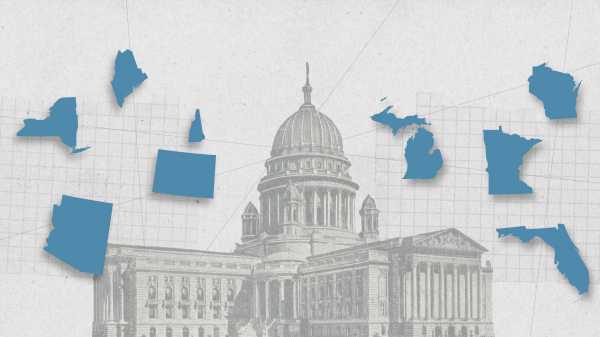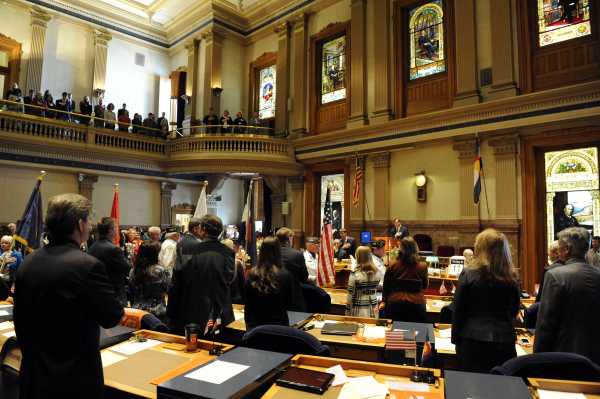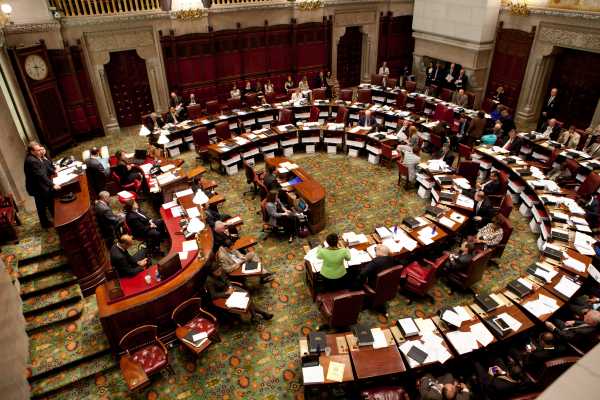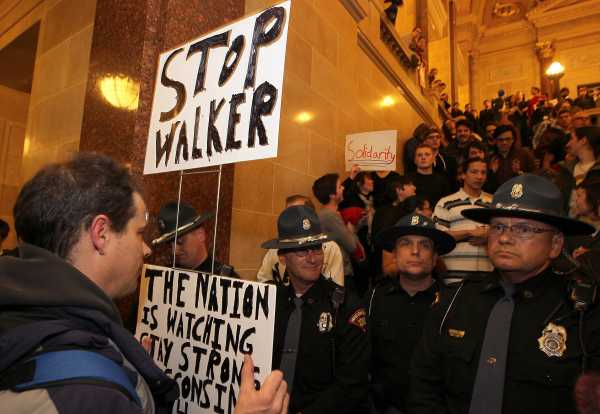
Democrats have a lot of work to do to make up the ground they lost in statehouses across the country during the Barack Obama years. It starts this November.
The state legislative elections in the 2018 midterms will be crucial for state-level policy debates, of course: Their outcome could determine the fate of abortion rights if the Supreme Court moves to undercut Roe v. Wade, the future of Medicaid expansion in some states, not to mention innumerable other issues like education, taxes, and labor rights.
And many state lawmakers elected in 2018 will still be in office in 2020, when the post-census redrawing of US congressional districts is set to begin. During the 2018 midterms, Democrats face a considerable disadvantage because of gerrymandering, a byproduct of the state-level losses they endured in 2010 before the last round of redistricting.
Big 2018 wins would provide them an opening to flip the script — or at least give them a seat at the table this time. It is no exaggeration to say that the 2018 state legislative races —and then the even more crucial 2020 elections — will help determine who controls the US House all the way through 2030. Democrats have reason to be hopeful after their big wins in Virginia last year, where the party took back the governor’s mansion and picked up eight state legislative seats in one night.
With thousands of state House and Senate seats on the ballot this year, we couldn’t possibly cover them all. But this is what you need to understand as Democrats begin the long work of rebuilding from the ground up, going from the states with the easiest paths to victory to the more difficult but still plausible battlegrounds.
Colorado

Who controls the state legislature? It’s split: Democrats already hold a 36-29 majority in the House, while Republicans are clinging to an 18-17 majority in the Senate (one independent caucuses with the Democrats). All data courtesy of the National Conference of State Legislatures.
How many seats do Democrats need to flip? Just one Senate seat. If they do that and hold the House, and Democrat Jared Polis wins the governor’s race, Democrats would have the trifecta for state control in Colorado. Right now, Democrats have total control in only eight states, according to the NCSL. Meanwhile, Republicans fully control 25 states.
How do voters here feel about their governor and President Trump? These metrics seemed like the best way to approximate how voters in every state feel about the national political environment, as well as their current state leadership.
President Trump is fairly unpopular in Colorado: 42 percent approve and 55 percent disapprove of him as of July, according to Morning Consult. Outgoing Democratic Gov. John Hickenlooper, on the other hand, enjoys 53 percent approval and just 30 percent disapproval, per the latest Morning Consult findings.
What are the specific races to watch? The Democratic Legislative Campaign Committee has identified 17 seats in eight states that could flip state legislative chambers this fall.
For Colorado, they are targeting the 24th Senate district, currently represented by Republican Sen. Beth Martinez Humenik, first elected in 2014. The Democratic candidate challenging Humenik is Faith Winter, a member of the House.
According to data compiled by the Daily Kos, this district voted 50-40 for Trump in the 2016 election. Democrats are likely banking on the big swings they’ve seen in places like Wisconsin and elsewhere, where Democratic candidates have prevailed in recent special elections in areas that Trump had won significantly.
What do election nerds say? Governing magazine’s Lou Jacobson, the best state-level handicapper in the business, thinks the race for the Colorado Senate is a toss-up.
Minnesota

Who controls the state legislature? Another divided statehouse: The Senate is evenly split, 33-33, with one vacant seat. The House is a taller order, with Republicans holding a 77-56 advantage, but Carolyn Fiddler at the Daily Kos told me it could be in play even if “it’s a heavy lift.”
How many seats do Democrats need to flip? Democrats have an unexpected chance to turn the Senate blue by flipping just one seat. Republican Sen. Michelle Fischbach resigned in May to become lieutenant governor, and there will be a special election to replace her in the fall.
On the House side, Democrats would need a significant wave to flip 12 seats and win a majority.
How do voters here feel about their governor and President Trump? Trump is deep underwater: 41 percent approval and 56 percent disapproval. Democratic Gov. Mark Dayton is term-limited, so he’ll leave office in 2019, but he’s quite popular: 51 percent approval and 35 percent disapproval.
What are the specific races to watch? The special election in Senate District 13 is what puts the Senate in play (otherwise, there are no Senate elections this year — the next regular Senate elections are in 2020). This is definitely Trump country: He beat Clinton here 64-30 in 2016. That is definitely the upper bound of how much one district can swing. But the DLCC still has the 13th on its list.
What do election nerds say? Jacobson hasn’t updated his ratings for the newly vacant Senate seat. As for the House, he thinks it is Likely Republican, but “if a Democratic wave develops, we may push the House to lean Republican.”
New York

Who controls the state legislature? Divided again. Democrats enjoy a healthy 104-41 majority in the House, but, thanks to a strange and now-endangered power-sharing agreement in which one Democrat caucuses with the Republicans, the GOP is in charge of the Senate with a narrow 32-31 majority.
How many seats do Democrats need to flip? Flipping one Senate seat would (finally) give Democrats full control of one of the most liberal states in the country.
How do voters here feel about their governor and President Trump? Trump’s home state really doesn’t like him: 38 percent approval and 58 percent disapproval.
Democratic Gov. Andrew Cuomo, who is facing a robust progressive challenge from Cynthia Nixon in his reelection race, has solid support: 48 percent approval, 39 percent disapproval.
What are the specific races to watch? The DLCC is focused on Senate District 7, where Democrat Anna Kaplan is challenging Republican incumbent Elaine Phillips, first elected in 2016.
This does look like a good pickup opportunity for Democrats: Phillips barely won in 2016, and Clinton actually beat Trump here: 55 percent to 42 percent.
What do election nerds say? Jacobson says the New York Senate is a toss-up.
Maine

Who controls the state legislature? Split and very narrowly so. Republicans have an 18-17 majority in the Senate, and Democrats hold a 74-70 advantage over the GOP in the House (there are also a handful of independent and Green Party members).
How many seats do Democrats need to flip? Just one Senate seat would do the trick. Democrats could also win the governor’s mansion, after eight years of Republican Gov. Paul LePage, for another new trifecta. The Democratic nominee, Maine Attorney General Janet Mills, is facing Republican Shawn Moody in that race.
How do voters here feel about their governor and President Trump? Trump fares a little better with Mainers: 48 percent approval and 49 percent disapproval.
But LePage, in his last months in office, is very unpopular: 40 percent approval and 54 percent disapproval.
What are the specific races to watch? Senate District 11 is where Democrats are concentrating their energies. Hillary Clinton eked out a 0.6-point victory over Trump in this district.
“Democrats have a good shot, but those districts tended to swing Trump’s way in 2016,” Fiddler said of the competitive Senate races in the Pine Tree State. “I don’t regard any of those as gimmes.”
What do election nerds say? Jacobson rates the Maine Senate as a toss-up, though he thinks a strong Democratic showing in the governor’s race could push it further in favor of the minority.
Wisconsin

Who controls the state legislature? Republicans. Their Senate majority is slim, 18-15, while their House majority is more substantial, 64-35.
How many seats do Democrats need to flip? Two Senate seats would give Democrats at least a foothold on power. In the governor’s race, Republican Gov. Scott Walker is probably a slight favorite, but Democrats have a chance to make up a lot of ground in Wisconsin.
How do voters here feel about their governor and President Trump? Morning Consult shows Trump with 41 percent approval and 55 percent disapproval, while a new NBC poll actually looked even worse for the president: 36 percent approval, 52 percent disapproval.
Walker isn’t looking so hot either: 42 percent approval and 50 percent disapproval, according to Morning Consult.
What are the specific races to watch? DLCC has Senate Districts 17 and 19 on its list. Trump won the former in 2016 by 9 points, 52-43, and the latter by 7 points, 50-43. You might recall that Wisconsin is where Democrats had one of their most impressive special election wins so far, taking a state Senate seat in January that Trump had won by 17.
What do election nerds say? Jacobson says the Wisconsin Senate is Lean Republican, edging toward toss-up territory. The House is likely to remain with the GOP, however, in his estimation.
New Hampshire

Who controls the state legislature? The GOP holds both chambers. The Senate is tight, with a 14-10 Republican majority. The New Hampshire House is a wonder of democracy, with 400 seats for one of the country’s smallest states. Republicans currently hold 214 to Democrats’ 170 (with a few vacancies and independents).
How many seats do Democrats need to flip? It’ll take three Senate seats to put Democrats back in power in that chamber. The House is a free-for-all with so many seats in play — though Fiddler told me that as the Senate goes, so might the House.
How do voters here feel about their governor and President Trump? Trump’s approval rating is middling to bad: 43 percent approval, 54 percent disapproval.
Republican Gov. Chris Sununu, the latest in a New Hampshire political dynasty, has broad support, though: 61 percent approval to just 22 percent disapproval, making him one of the most popular governors in the country.
What are the specific races to watch? Senate Districts 8, 23, and 24 are the Democratic priorities. The House is simply impossible to forecast with so many seats.
Trump won Senate Districts 8 and 23 by the exact same margin: 51 percent to 44 percent. Clinton actually won a photo finish in Senate District 24, with a 0.04-point advantage.
What do election nerds say? According to Jacobson, both the New Hampshire House and the Senate are toss-ups. The trifecta is unlikely since Sununu is so popular, but Democrats absolutely could take over the state legislature.
Arizona

Who controls the state legislature? Republicans control the Senate with a 17-13 majority and the House with a 35-25 majority.
How many seats do Democrats need to flip? In the Senate, it would take a three-seat swing to give Democrats a toehold in this currently GOP-dominated state.
How do voters here feel about their governor and President Trump? Trump is doing okay here: a 48-48 split on approval and disapproval.
Republican Gov. Doug Ducey has “meh” favorability: 41 percent approval and 43 percent disapproval. He is notably back on the ballot in 2018.
What are the specific races to watch? The DLCC thinks Senate Districts 6, 17, and 28 are the party’s best opportunities.
The Sixth District went 52-42 for Trump in 2016, the 17th was a little closer (49-45 Trump), and the 28th voted for Clinton, 50 percent to 45 percent.
What do election nerds say? Jacobson rates the Arizona Senate as Lean Republican. His analysis is worth reading in full:
Florida

Who controls the state legislature? Republicans again. Their 23-16 Senate majority could be in jeopardy, while their House majority is probably unassailable: 76-41.
How many seats do Democrats need to flip? Five Senate seats would do it — a taller order than most others on this list, but certainly within reach.
With Republican Gov. Rick Scott term-limited out and running for US Senate, Democrats could regain a lot of power in Florida this year. The governor’s race looks like a toss-up.
How do voters here feel about their governor and President Trump? The Sunshine State still likes Trump: 51 percent approval and 45 percent disapproval.
Scott is quite popular — 54 percent approval, 35 percent disapproval — though we’ll see if that lasts in what promises to be a bruising Senate campaign. He may also still be enjoying a boost after his widely praised response to the Parkland high school shooting.
What are the specific races to watch? Senate Districts 8, 16, 18, 22, and 36 are the Democratic targets.
Their 2016 presidential results:
- Senate District 8: Trump 48.2; Clinton 48
- Senate District 16: Trump 54, Clinton 42
- Senate District 18: Clinton 51, Trump 45
- Senate District 22: Trump 52, Clinton 45
- Senate District 36: Clinton 56, Trump 42
Fiddler observed that thanks to voter-approved redistricting in Florida, Democrats should have a legitimate shot to win the Senate seats they need. “Not as bad as it used to be,” she said.
What do election nerds say? Jacobson thinks the Florida Senate is Lean Republican, though he gives the Democrats a real chance of flipping it.
“For the first time in a quarter-century, Florida Democrats have a genuine chance of seizing control of a state legislative chamber,” he wrote.
Michigan

Who controls the state legislature? Republicans have big majorities: 27-10 in the Senate and 63-46 in the House.
How many seats do Democrats need to flip? A whole lot. The House is probably the target here: Democrats would need to flip 10 Republican-held seats for a bare majority.
How do voters here feel about their governor and President Trump? This was the site of one of Trump’s most surprising 2016 victories, but Michiganders are souring on him, with 44 percent approving and 52 percent disapproving of the president.
Republican Gov. Rick Snyder is on his way out, and he is very, very unpopular (perhaps a remnant of the Flint water crisis): just 35 percent approval and 50 percent disapproval. That can only help the Democratic odds.
What are the specific races to watch? There are probably too many seats here to zero in on any specific races, and the DLCC didn’t include Michigan in its targets. But Fiddler named the Michigan House as the “sleeper chamber” of 2018.
“Michigan has term limits, and a lot of anti-Obama babies are term-limited out this year,” she said. “Lot of open House seats.”
It might not hurt that there will be a competitive governor’s race, giving Democrats an opening to retake the state’s top elected office, and that Democratic Sen. Debbie Stabenow looks likely to cruise to reelection.
What do election nerds say? Jacobson seems to agree: He rates the Michigan House as merely Lean Republican in spite of the sizable GOP majority.
Sourse: vox.com






